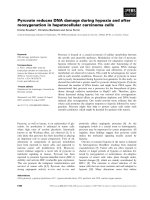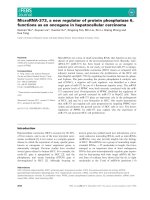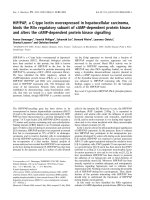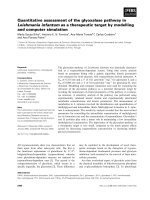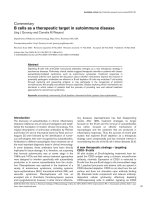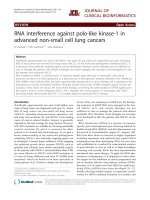Polo like kinase 1 in hepatocellular carcinoma clinical significance and its potential as a therapeutic target
Bạn đang xem bản rút gọn của tài liệu. Xem và tải ngay bản đầy đủ của tài liệu tại đây (2.13 MB, 84 trang )
POLO-LIKE KINASE 1 IN HEPATOCELLULAR
CARCINOMA: CLINICAL SIGNIFICANCE AND ITS
POTENTIAL AS A THERAPEUTIC TARGET
MOK WEI CHUEN
B.Sc. (Hons.), NUS
A THESIS SUBMITTED
FOR THE DEGREE OF MASTER OF SCIENCE
DEPARTMENT OF MEDICINE
NATIONAL UNIVERSITY OF SINGAPORE
2008
ACKNOWLEDGEMENT
My sincere gratitude goes to the following persons:
-
Supervisor, Associate Professor Dr. Lim Seng Gee
-
Dr. Shanthi Wasser
-
Associate Professor Dr. Theresa Tan May Chin
-
Dr. Aung Myat Oo
I would like to extend my appreciation to all the colleagues in Hepatology and
Gastroenterology research laboratory for all their helps and guidance.
I would also like to take this opportunity to thank my parents and friends for their
loves and supports.
Thank you.
i
TABLE OF CONTENTS
Contents
Page No.
Acknowledgement……………………….…………………………………………….i
Literature Review……………………...……………………….……………….iv - xvii
Literature Review: List of Table and Figure……………………..…………………...xvi - xvii
Table I………………………………………………………………………………………xvi
Table II………………….…………………………………………………………….……xvii
Figure I……………………………………………………………………………….……xvii
Thesis………………………………….…………………………………………..1 - 66
Abstract………..………………………….……………………………………………………….1
Introduction………………………………....…………………………………………………2 - 4
Materials and Methods………………………...……………………………………………5 - 12
Results………………………………………………………………………………………13 - 19
Discussion…………...………………………………………...…………………………..20 – 24
List of Table…………………………………………………………………………………25– 27
Table 1………………………………………………………………………………………25
Table 2………………………………………………………………………………………26
Table 3………………………………………………………………………………………27
List of Figure…………..................................…………………………………………28 – 38
Figure 1……………………………………………………………………………………..28
Figure 2……………………………………………………………………………………..29
Figure 3……………………………………………………………………………………..30
Figure 4……………………………………………………………………………………..31
Figure 5……………………………………………………………………………………..31
Figure 6……………………………………………………………………………………..32
Figure 7……………………………………………………………………………………..33
ii
Figure 8………………………………...…………………………………………………..34
Figure 9……………………………………………………………………………………..35
Figure 10……………………………………………………………………………………36
Figure 11……………………………………………………………………………………37
Figure 12……………………………………………………………………………………38
Figure 13……………………………………………………………………………………39
References…..….………………………………………………………...…......40 – 63
Appendix………………………………………………..……………………….64 - 66
iii
LITERATURE REVIEW
History of Polo-like Kinases
The family of Polo-like kinases (PLKs) plays important roles in cell cycle progression,
especially in the event of mitosis. (Glover et al., 1998; Nigg, 1998) It was first
discovered as Polo in Drosophila melanogaster over twenty years ago where
neuroblast cells that were homozygous for the mutated polo alleles showed abrupt
spindle formation that resulted in polyploidy cells. (Sunkel and Glover, 1988)
Following this, PLKs homologues in yeast, worm, frog, mouse and human are also
discovered (Tab. I). All PLKs contain the highly conserved Ser/Thr kinase domains at
the N-termini and polo-box(s), a string of highly conserved thirty amino acids, at the
non-catalytic C-termini. (Lowery et al., 2005) In Saccharomyces cerevisiae, a
loss-in-function of Cdc5 can be readily compensated by over-expressing either
mammalian PLK1 or PLK3. (Lee and Erikson, 1997; Ouyang et al., 1997) It is
therefore evident that PLKs’ functions are conserved throughout evolution, implying
their importance in species survival.
Structures and Domains of Polo-like Kinases
As mentioned, Polo-like kinases contain two highly conserved structural features, the
kinase domains and the polo-box domains. (Fig. I) The N-terminal Ser/Thr kinase
domain contains a T-loop that is important for PLK activation through
phosphorylation at specific residues, which is common to other kinases as well.
iv
(Johnson et al., 1996) Mutation of a conserved residue in the T-loop, Thr210, in
human PLK1 to Asp that mimics phosphorylated Thr210 can cause activation of
PLK1. (Jang et al., 2002b) Similar event also has been reported in Xenopus laevis
Plx1 at Thr201. (Qian et al., 1999) With reference to Protein Kinase A, the
phosphorylation is believed to stabilize the T-loop in an open and extended
conformation to facilitate substrate binding. (Knighton et al., 1991a; Knighton et al.,
1991b) In human PLK1, the substrate recognition motif has been elucidated, which
consists of Glu/Asp at the -2 position and a hydrophobic residue in the +1 position
relative to the phosphorylated Ser/Thr residue. (Lowery et al., 2005)
Polo-box domain (PBD) is a unique signature for PLKs that harbors two tandem
polo-box repeats except for Sak or PLK4 that only has a single polo-box. (Leung et
al., 2002) PBD has been showed to involve in negatively regulating PLKs kinase
activity as C-terminal deletion in wild-type and T210D PLK mutant gain noticeable
increase in kinase activity. (Jang et al., 2002a; Mundt et al., 1997) Another interesting
function of PBD lies in its ability to localize PLKs to certain cellular structures, most
prominently to centrosomes and midbody/midzone at certain stages in mitosis.
(Golsteyn et al., 1994; Lee et al., 1995) A recent breakthrough in exploring the
molecular basis of PBD reveals the PBD as a phosphopeptide-binding motif and this
shed lights on the mechanism regarding spatial and temporal regulations of PLKs at
various stages of mitosis. (Elia et al., 2003a; Elia et al., 2003b)
The optimal phosphopeptide motif that is recognized by PBD of PLKs is determined
through
peptide
library
screening
and
revealed
as
[Pro/Phe]-[φ/Pro]-[φ/AlaCdc5p/GlnPLK2]-[Thr/Gln/His/Met]-Ser-[pThr/pSer]-[Pro/
v
X] (φ represents hydrophobic amino acids), with strong selection for Ser in the
pThr/pSer-1 position, which is observed in all members of human PLKs, Xenopus
Plx1, and Saccharomyces cerevisiae Cdc5p. (Elia et al., 2003b) Crytallized structure
of human PLK1 PBD binding the optimal motif (Pro-Met-Gln-Ser-pThr-Pro-Leu)
further identifies other key residues that are important in mediating the
phosphopeptide binding. (Elia et al., 2003b) These include His-538 and Lys-540,
which if mutated to Ala will abolish the binding. (Elia et al., 2003b) The side chains
of these two residues form a pincer-like arrangement that establish direct contact with
the phosphate group as revealed from the crystal structure. (Elia et al., 2003b)
Another key residue that is important to the phosphopeptide binding is the critically
conserved Trp-414, (Elia et al., 2003b) which has been showed to eliminate
centrosomal localization of PLK1 in W414F PLK1 mutant. (Lee and Erikson, 1997)
Considering the capability of phosphopeptide-binding of PBD, it is therefore rational
to infer that PLKs are being localized and regulated through their PBD. PLKs can be
localized to the target proteins that have been phopshorylated prior by cell cycle
kinases such as Cell cycle-dependent kinase 1 (Cdk1) to generate docking sites for
PLKs via their PBD. (Elia et al., 2003a; Elia et al., 2003b) Interestingly, PLK1 can be
blocked from its binding partner, microtubule-associated protein regulating
cytokinesis (Prc1) by Cdk1 until Cdk1 activity wanes during anaphase. (Neef et al.,
2007) These are excellent examples on both the spatial and temporal regulations of
PLK1s through their PBD by cell cycle kinases.
vi
Functions of Polo-like Kinases
Cell cycle is a tightly regulated physiological process that employs multiple
checkpoints during G1, S, G2, and M phases to ensure the fidelity of genome
replication and thus its integrity to prevent genome instability. (Elledge, 1996) As
with other cell cycle kinases, PLKs expressions are tightly regulated in a cyclical
fashion with low expressions in G1 phase and peak at G2/M phase, which coincide to
its roles in mitosis. (Golsteyn et al., 1994) PLKs expressions throughout the cell cycle
are mainly regulated through phosphorylation and ubiquitin-dependent proteolysis
that involves the anaphase promoting complex/cyclosome with its activator Cdh1
(APC/CCdh1). (Nigg, 2001; Peters, 2002) The functions of human PLK1 are currently
the most elaborated and therefore will be the focus for this review. In addition,
examples from other species or its other members will be highlighted when it deems
suitable.
Replication of the chromosomes during S phase is monitored strictly by the DNA
damage checkpoint to prevent any genome defects from passing to the daughter cells.
(Zhou and Elledge, 2000) PLK1’s role in this phase has been identified as a possible
target of ataxia telangiectasia mutated (ATM) or ATM-related proteins (ATR), the
transducers of the DNA damage signaling pathway. (van Vugt et al., 2001) Activity of
PLK1 is inhibited when the DNA damage checkpoint is activated following an insult
to the genome. The inhibition appears to be mediated by blocking PLK1 activation
because expression of PLK1 activation mutant (T210D/S137D) can partially override
the DNA damage-induced G2/M arrest. (Smits et al., 2000) The actions of ATM/ATR
on PLK1 are later demonstrated by using radio-sensitizing agent i.e., caffeine that
vii
specifically inhibits ATM/ATR and reverses the PLK1 inhibition during
radiation-induced DNA damage. (van Vugt et al., 2001)
PLK1 has been showed to immunoprecipitate together with tumor suppressor p53,
which resulted in terminating the trans-activating activity of p53. (Ando et al., 2004)
p53 expression is greatly enhanced when DNA damage checkpoint is activated and its
function is to arrest the cell cycle at G1 via the action of p21 in order to repair the
damaged DNA; or to initiate apoptosis if the damage is too extensive. (Levine, 1997)
However, expression of ATM can antagonize the inhibitory effect of PLK1 on p53.
(Ando et al., 2004) Therefore, ATM/ATR inhibition of PLK1 seems crucial to allow
G2/M arrest and may help in liberating p53 from the inhibitory effect of PLK1 in
response to DNA damage. Other members of the PLKs family, PLK2 and PLK3 have
also been implicated in DNA damage response but PLK3 seems to play a more
prominent yet contrary role. Instead of negatively affecting the DNA damage
checkpoint, PLK3 positively regulates p53 activity and therefore promoting cell cycle
arrest. (Xie et al., 2005)
Cell division cycle 2 (Cdc2)/Cyclin B complex orchestrates the events during M
phase and its activation during mitotic onset requires cell division cycle 25 homolog
C (Cdc25C) and Cdk-activating kinase (Cak). (Nigg, 2001) PLK1 can phosphorylate
Cdc25C and cause activation of the phosphatase in vitro, which suggests PLK1 may
involve in the activation of Cdc2. (Roshak et al., 2000) Emerging studies have also
described that nuclear translocation of Cdc25C can be mediated by PLK1
phosphorylation. (Bahassi el et al., 2004; Toyoshima-Morimoto et al., 2002)
Toyoshima-Morimoto et al. (2002) showed phosphorylation of Cdc25C by PLK1 at
viii
Ser198, which was located in a nuclear export signal, promoted its nuclear
translocation in vivo whereas a mutation that convert Ser-198 to alanine would abolish
the translocation of Cdc25C to nucleus. Similar physiological observation has also
been found on cyclin B1 where PLK1 phosphorylation leads to nuclear accumulation
of cyclin B1. (Toyoshima-Morimoto et al., 2001) However, contrary results have
been reported as well that show no evidences for PLK1 in regulating the nuclear
translocation of cyclin B1. (Jackman et al., 2003) Therefore, such discrepancies still
await further clarifications.
Although PLK1 plays important roles in S and G2/M phase of the cell cycle as
described previously, its major physiological function lies in the M phase. Silencing
studies on PLK1 show cells are only arrested after entry into mitosis but not earlier,
indicating that PLK1’s functions in S and G2/M phases are less essential to cell cycle
progression before mitosis. (Liu and Erikson, 2002; Seong et al., 2002; van Vugt et al.,
2004) Instead, the characteristic events when PLKs activities are impaired are usually
associated with aberrant spindle formations and failed cytokinesis. (Ohkura et al.,
1995; Sunkel and Glover, 1988) Several evidences have implicated PLK1 in
regulating the bipolar spindle formations during onset of mitosis. Centrosomal protein
Ninein-like protein (Nlp) is dissociated from γ-tubulin and centrosomes upon
phosphorylation by PLK1 and such dissociation is required for proper spindle
formations to take place. (Casenghi et al., 2003) PLK1 also phosphorylates the
microtubule stabilizing proteins TCTP and causes these proteins failed to stabilize
microtubules, which will presumably increase the microtubules dynamics required
during spindle formations. (Xie et al., 2005; Yarm, 2002) Other origins of PLKs have
also showed to interact with proteins involved in spindle formation such as
ix
Stathmin/Op18 in Xenopus laevis (Budde et al., 2001), and Abnormal spindle protein
(Asp) in Drosophila melanogaster. (do Carmo Avides et al., 2001)
Besides regulating the formations of spindle assembly, PLK1 has also been showed to
localize to kinetochores during mitosis. (Arnaud et al., 1998) Kinetochores are
proteinaceous structures where the spindle microtubules bind and the sites where
motor proteins assemble to drive the movement of chromatids separation. Unattached
kinetochores will signal the activation of the spindle checkpoint. (Cleveland et al.,
2003) APC/C is the main inhibitory target in the spindle checkpoint as it is
responsible in separating sister chromatids by liberating separase from securin.
(Musacchio and Hardwick, 2002) PLK1 contributes to the regulation of spindle
checkpoint via a few ways, which is mainly to bring about the activation of APC/C.
Firstly, Early-mitotic inhibitor (Emi1) is an inhibitor of APC/C and phosphorylation
of Emi1 within the DSGxxS sequence by PLK1 generates a phospho-degron that
promotes binding with Skp1-Cullin-F-boxβ-TRCP (SCFβ-TRCP) ubiquitin ligase
complexes, leading to the destruction of Emi1 and thus liberating APC/C. (Moshe et
al., 2004b)
Secondly, when the spindle checkpoint is activated, an array of associated checkpoint
proteins including Bub1, BubR1, Bub3, Mad1, Mad 2, and CENP-E will be activated
to inhibit APC/C through direct interactions with Cdc20, an activator for APC/C.
(Bharadwaj and Yu, 2004) PLK1 may directly regulate these components such as
BubR1 (Matsumura et al., 2007) and possibly Mad2 (Eckerdt and Strebhardt, 2006) in
order to prevent APC/C inhibition and promote mitosis progression. PLK1 can also
interact with components of APC/C as showed in mouse PLK1 and in
x
Schizosaccharomyces pombe Plo1 to bring about APC/C activation. (Golan et al.,
2002; Kotani et al., 1998) Lastly, PLK1 homologues have also been implicated in
promoting sister chromatids separation in Saccharomyces cerevisiae and Xenopus
Laevis. (Alexandru et al., 2001; Lee and Amon, 2003; Losada et al., 2002) A recently
discovered spindle checkpoint associated protein known as PLK1-interacting
checkpoint "helicase" (Pich) has been implicated in monitoring the tension developed
between sister kinetochores. Its localization to kinetochores depends on the actions of
Cdk1 and PLK1. Therefore, PLK1 may also involve in regulating the tension
generated between sister kinetochores during mitosis via Pich. (Baumann et al.,
2007)Although much is still waiting to be discovered on the various functional roles
of PLK1 in regulating the spindle checkpoint, its functions are indisputably essential
in promoting cell cycle progression through mitosis.
Studies in Schizosaccharomyces pombe have revealed PLKs roles in regulating
septation, (Ohkura et al., 1995) which implied cytokinesis in mammalian cells can be
also under the regulation of PLKs. Since impairment of PLKs activities in mammalian
cells usually leads to mitotic arrest, it is therefore challenging to study PLKs’ roles in
cytokinesis. (Barr et al., 2004) Still, there are few reports that provide some insights
in this particular role of PLKs. For instance, overexpression of PLK1 will lead to
generation of large cells that have multiple nuclei, which is consistent with failed
cytokinesis. (Mundt et al., 1997) Phosphorylations of motor proteins that are part of
the
Dynein
complex
like
Mitotic
kinesin-like
protein
2
(Mklp2)
and
Nuclear-distribution gene C (NudC) by PLK1 are crucial for cytokinesis as such
phosphorylations are required to localize Mklp2 and NudC to the central spindle
together with PLK1. Both Mklp2 and NudC can interact with PBD of PLK1, which
xi
suggests that PLK1 may mediate their localization. (Aumais et al., 2003; Neef et al.,
2003; Nishino et al., 2006; Zhou et al., 2003) Another kinesin-related motor protein
Pavarotti has also been showed to co-localize with PLK1. (Adams et al., 1998) Recent
studies in Golgi dynamics during mitosis have also showed PLKs involvement in
phosphorylation of a peripheral golgi protein Nir2 with Cdk1 providing the binding
sites for PLK1. (Litvak et al., 2004)
Polo-like Kinases and Cancers
Transformation of normal cells to malignant cells requires acquisition of multiple
genetic defects that eventually contribute to deregulated cells proliferation.
(Vogelstein and Kinzler, 1993) Among these genetic defects, genes regulating the cell
cycle are often implicated e.g., p53, Ras and Myc, of which the deregulation of these
proteins will generally promote proliferation of cells. (Carnero, 2002) PLK1 is also a
potent oncogene and its over-expression can transform NIH3T3 cells into developing
tumors in nude mice. (Smith et al., 1997) Many tumors have reported
over-expressions of PLK1 (Tab. II). In tumors such as non-small-cell lung cancer,
colon cancer, heck and neck cancer, melanoma, bladder cancer and hepatoblastoma,
PLK1 expressions have significant prognostic values. (Knecht et al., 1999; Knecht et
al., 2000; Kneisel et al., 2002; Nogawa et al., 2005; Strebhardt et al., 2000; Takahashi
et al., 2003; Wolf et al., 1997; Yamada et al., 2004) In addition, high expressions of
PLK1 in melanoma and breast cancer correlate well to the metastatic potential of
those tumors. (Ahr et al., 2002; Kneisel et al., 2002)
It is therefore apparent that PLK1 is a potential cancer therapy target that can be
xii
applied in a broad range of cancers. Indeed, several studies using short interfering
RNA (siRNA) mediated silencing of PLK1 gene expressions in gastric cancer (Chen
et al., 2006b; Jang et al., 2006), prostate cancer (Shaw and Ahmad, 2005), breast
cancer (Spänkuch et al., 2007), bladder cancer (Nogawa et al., 2005) and other cancer
cell lines (Guan et al., 2005; Liu and Erikson, 2003; Spänkuch et al., 2002) showed
significant increases in apoptosis and tumors growth is impeded. In contrast, normal
cells such as hTERT-RPE1, human retinal pigment epithelial cell line that stably
expresses human telomerase reverse transcriptase (hTERT), MCF10A, spontaneous
immortalized human diploid breast epithelial cells and HMEC, human mammary
epithelial cells exhibit no increased apoptosis although with reduced rates of mitosis
when PLK1 expressions are silenced. (Liu et al., 2006; Spänkuch et al., 2002) These
studies support PLK1 as a suitable anti-cancer target and perhaps with only minor
side effects. In fact, two highly selective small molecule inhibitors of PLK1: BI 2536
and ON01910 are undergoing clinical trials currently. (Gumireddy et al., 2005; Mross
et al., 2005b; Steegmaier et al., 2007a; Steegmaier et al., 2007b)
Hepatocellular carcinoma (HCC) is the 5th common solid tumor cancer in the world
and is ranked 3rd in term of mortality according to GLOBALCAN 2002. (Ferlay et al.,
2004) Chronic Hepatitis B and C are two of the main etiological agents for HCC,
while non-alcoholic steatohepatitis (NASH) begins to receive attention as one of the
high risk factors in HCC. (Bruix and Sherman, 2005; El-Serag and Rudolph, 2007)
HCC is usually preceded by chronic liver injuries such as hepatitis or cirrhosis that
may persists for a period of 20-40 years before finally developing into HCC. During
the long latent period, hepatocytes at site of lesion gradually acquire genetic
alterations to become dysplastic and eventually malignant. (Thorgeirsson and
xiii
Grisham, 2002) The exact underlying mechanism of HCC pathogenesis is still
remained largely unknown although some hypothesized that the high proliferation rate
of hepatocytes during early phase of chronic liver injuries can create a favorable
condition for hepatocytes to acquire mutations. It is suggested that senescence of
hepatocytes due to telomere shortening as a result of enhanced proliferation rate will
greatly reduce the number of functional hepatocytes. Minor population of these
senescent hepatocytes may escape apoptosis and enter a state of genomic instability
that may promote acquisition of oncogenes. In addition, the inflammatory state of the
liver will probably promote tumorigenesis by releasing arrays of tumor promoting
factors such as growth factors, chemokines or cytokines. (El-Serag and Rudolph,
2007)
Surgical treatments including partial hepatectomy and orthotopic liver transplantation
remain as the most prospective cures for HCC patients because the effectiveness of
conventional chemo- or radiotherapy is lacking. While liver transplantation remains
as an limited option, resected patients on the other hand faced with poor prognosis
where about 75% of the HCC patients that had undergone resections suffered from
recurrence (Bruix and Llovet, 2002; Llovet et al., 1999). Considering the high
mortality rate of HCC and the very limited effective treatments available, it is
therefore imperative to embark on other therapy options such as gene therapy that
may harbor great potentials. Hence, it is interesting to examine PLK1 expressions in
HCC and to evaluate its potential of being a therapeutic target in treating HCC.
xiv
Future Prospects of Polo-like Kinases
PLKs have started to emerge as another major key player in cell cycle besides the
well-known cell cycle dependent kinases and their associated cyclins. Potential PLKs’
downstream substrates and upstream regulators discovery will further enhance our
understanding in the molecular mechanism of PLKs in regulating mitosis, especially
with the helps from the crystallized structure of the PBD and the recently available
crystallized kinase domain of PLK1. (Kothe et al., 2007) Localization of PLK1 to
kinetochores and being able to phosphorylate kinetochores that are not under tension
(Ahonen et al., 2005; Wong and Fang, 2005) as well as the discovery of Pich have
provided important insights in the signaling pathways that interpret tension changes at
kinetochores, which can be channeled to regulate the spindle checkpoint instead.
Indeed, PLKs still have many novel functions that await future explorations and such
discoveries will definitely enhance the understandings on the intricate regulation of
cell cycle. The spotlight is now on PLKs as the next potential therapeutic targets in
gene therapy that can be applied onto various kinds of cancers. Encouraging results
from silencing experiments on different cancers implied that PLKs inhibitors with
high potency and efficacy can be engineered and used as anti-cancer drugs. (Eckerdt
et al., 2005) With the increasing research interests in PLKs, one can anticipate more
future discoveries be made on the intricate regulations and novel functions of the
PLKs family members.
xv
LITERATURE REVIEW: LIST OF TABLE AND FIGURE
Table I: Polo-like kinase (PLK) in different organisms.
Organism
Saccharomyces cerevisiae
PLK
Cdc5
Schizosaccharomyces pombe
Plo1p
Caenorhabditis elegans
Plc1, Plc2, Plc3
Drosophila melanogaster
Polo
Xenopus laevis
Plx1, Plx2, Plx3
Mammals (Human and mouse)
PLK1, PLK2
(SNK), PLK3
(FNK, PRK),
PLK4 (SAK)
Reference
(Kitada et al.,
1993)
(Ohkura et al.,
1995)
(Chase et al., 2000;
Ouyang et al.,
1999)
(Llamazares et al.,
1991; Sunkel and
Glover, 1988)
(Duncan et al.,
2001; Kumagai and
Dunphy, 1996)
(Clay et al., 1993;
Fode et al., 1994;
Golsteyn et al.,
1994; Hamanaka et
al., 1994; Karn et
al., 1997; Lake and
Jelinek, 1993; Li et
al., 1996; Ouyang
et al., 1997;
Simmons et al.,
1992)
Cdc, cell division cycle; Plo (Polo); Plc (Polo-like kinase of C. elegans); Plx
(Polo-like kinase of X. laevis); Snk (serum-inducible kinase); Fnk
(fibroblastgrowth-factor-indiucible kinase); Prk (proliferation-related kinase); Sak
(Snk akin kinase).
xvi
Table II: Polo-like kinase 1 overexpression in various tumors.
Tumor
Non-small-cell lung cancer
Reference
(Wolf et al., 1997)
Gliomas
(Dietzmann et al., 2001)
Head and neck cancer
(Knecht et al., 1999; Knecht et al., 2000)
Ovarian cancer
(Takai et al., 2001a; Weichert et al., 2004a)
Breast cancer
(Ahr et al., 2002; Weichert et al., 2005b; Wolf et al.,
2000)
Colorectal cancer
(Macmillan et al., 2001; Takahashi et al., 2003;
Weichert et al., 2005a)
Endometrial cancer
(Takai et al., 2001b)
Esophageal and gastric cancer
(Tokumitsu et al., 1999)
Pancreatic cancer
(Gray et al., 2004; Weichert et al., 2005c)
Prostate carcinoma
(Weichert et al., 2004b)
Papillary carcinoma
(Ito et al., 2004)
Hepatoblastoma
(Yamada et al., 2004)
Non-Hodgkin lymphoma
(Mito et al., 2005)
Melanoma
(Kneisel et al., 2002; Strebhardt et al., 2000)
Bladder cancer
(Nogawa et al., 2005)
Diffuse large B-cell lymphoma (Liu et al., 2007)
Figure I
Figure I: Structure and domains of Polo-like kinase (PLK). Key residues involved in
the function of PLK are indicated. PB1/2 (Polo-box 1/2). Source: Lowery et al., 2005.
xvii
ABSTRACT
Polo-like kinase 1 (PLK1) plays important roles in the progression of cell cycle,
especially for cells to transit from anaphase to telophase during mitosis. PLK1 is
overexpressed in various cancers and has significant prognostic values. In this study,
PLK1 gene expression was evaluated in Hepatocellular carcinoma (HCC) and found
to be overexpressed frequently in HCC patients. Gene silencing technology utilizing
short interfering RNA (siRNA) was subsequently employed to study the potential of
PLK1 to be the therapeutic target in treating HCC. The results from this study showed
significant anti-proliferative effect in a human hepatoma cell line Huh-7 that
overexpressed PLK1 when PLK1 gene expression was silenced. Silencing of PLK1
gene expression also induced caspase-independent apoptosis pathway in Huh-7 with
endonuclease G identified as the potential main apoptotic effector. Forkhead box M1
(FOXM1) gene expression was found to correlate positively to the gene expression of
PLK1 within the same patient cohort in this study. However, silencing of FOXM1
gene expression did not affect the gene expression of PLK1 in Huh-7 suggesting that
there are other undefined transcription factors that regulate PLK1 gene expression in a
compensatory or synergistic way. The therapeutic potential of PLK1 was further
examined in nude mice that were transplanted subcutaneously with Huh-7 in matrigel.
Intratumor injection of siRNA targeted at PLK1 had successfully impeded the tumor
growth. In conclusion, PLK1 is overexpressed in HCC and silencing of PLK1 gene
expression produces anti-tumor effects that make PLK1 to be the potential therapeutic
target in the treatment of HCC patients.
1
INTRODUCTION
Hepatocellular carcinoma (HCC) is the 5th common solid tumor cancer in the world
and is ranked 3rd in term of mortality according to GLOBALCAN 2002. (Ferlay et al.,
2004) African and Asian countries such as China and South Korea have very high
incidence rates of HCC, which are also countries that are endemic for Hepatitis B.
(El-Serag and Rudolph, 2007) Chronic Hepatitis B and C are the two most
well-known risk factors for HCC among other risk factors such as heavy alcohol
intake and aflatoxin poisoning. (Bruix and Sherman, 2005) Non-alcoholic
steatohepatitis (NASH) presents another unconventional risk factor that may be
resulted from diabetes mellitus and obesity although such correlations still require
further supporting studies. (El-Serag and Rudolph, 2007)
The exact underlying mechanism of pathogenesis of HCC is still elusive. It has a long
latent period of about 20 to 40 years while the patients may be suffering from chronic
liver injuries such as hepatitis or cirrhosis. It is suggested that to compensate the liver
injuries, hepatocytes undergo enhanced proliferation and subsequently enter
senescence due to telomeres shortening. However, the chronic inflammatory state of
the liver has resulted in arrays of growth factors, chemokines and cytokines being
secreted thus creating a niche that favor the proliferation of hepatocytes even in
senescence state. Such condition will eventually exhaust the telomeres completely and
causes genomic instability. It is possible that along these series of events, hepatocytes
can acquire the necessary genetic alterations and consequently become malignant.
(El-Serag and Rudolph, 2007; Thorgeirsson and Grisham, 2002)
2
Orthotopic liver transplantation remains to be the most curative treatment for HCC
patients especially for those who are having unresectable HCC. However, it is very
limited by the availability of suitable donors. While conventional chemo- or
radiotheraphy lacks its effectiveness in treating HCC due to resistances, surgical
resections or local ablations of HCC are suffered from poor prognosis as depicted by
the low 5-year survival rates of 17% to 53%. (Chen et al., 2006a; Yamamoto et al.,
1996) Another main concern for resected HCC patients is the possibility of recurrence
that can happen in about 75% of the resected HCC patients. (Bruix and Llovet, 2002;
Llovet et al., 1999) The lack of effective treatment options prompts for other therapy
alternatives that can provide better treatment outcomes for HCC patients. A genomic
approach to study HCC may be able to tackle this task and has actually beginning to
show promising results.
Recent genomic studies in HCC have helped in deciphering the possible underlying
molecular mechanisms that lead to HCC. (Pang et al., 2006; Thorgeirsson and
Grisham, 2002) Many genes are identified to be associated with HCC and some have
showed high prognostic or therapeutic potentials. (Avila et al., 2006) For instance,
tumor suppressor gene p53 is one of the genes that is mutated in about 24% to 69% of
HCC (Beerheide et al., 2000; Osada et al., 2004; Soini et al., 1996) and is associated
with poor survival. (Hayashi et al., 1995; Sugo et al., 1999) Re-introducing wild type
p53 gene into p53 knockout HCC cells using retroviral vector is showed to be able to
prevent tumor growth and increases the sensitivity against chemotherapy. (Xu et al.,
1996) While the efficiency of p53 gene delivery in a clinical setting still requires
further technical optimization, it nonetheless provides insights in the potentials of
3
gene therapy. (Warren and Kirn, 2002)
By using the available published microarray data on HCC, (Chen et al., 2002; Lee et
al., 2004; Okabe et al., 2001) ten gene candidates that showed up-regulation were
chosen for gene expressions analysis using real-time reverse transcription (RT)
quantitative PCR on 56 paired tumor/non-tumor liver samples from resected HCC
patients who are HBV-positive. Among these ten gene candidates, Polo-like kinase 1
(PLK1) was chosen to be further evaluated using short interference RNA (siRNA)
technology to assess its potential as a therapeutic gene target in HCC treatment. PLK1
is a cell cycle kinase with unique structural properties that involves in M-phase and
has been showed to be over-expressed in various other tumors. (Takai et al., 2005)
4
MATERIALS AND METHODS
Patients and Samples
Tumor and surrounding non-tumor liver tissues were obtained from 56 primary HCC
patients who underwent liver resection in National University Hospitals from 1998 to
2002. All patients were identified to be Hepatitis B positive and of Asian ethnicity.
The patients were from 49 males and 7 females of aged 32 to 82 years (mean, 56
years). The tumors were histologically classified by Department of Pathology,
National University of Singapore. The study was approved by the National University
of Singapore Institutional Review Board and National Healthcare Group Domain
Specific Review Boards. Informed consents were obtained from every patient on the
use of the tissues. The human hepatoma cell lines HepG2 was obtained from
American Type Culture Collection (ATCC number: HB-8065), Huh-7 was from
Japanese Collection of Research Bioresources Cell Bank (Cat# JCRB0403), and
HepG2.215 was kindly provided by Dr. Acs (Mt. Sinai Medical College, New York,
NY). HepG2 and Huh-7 were cultured in Dulbecco’s modified Eagle’s medium
supplemented with 0.1 mM sodium pyruvate, 0.1 mM L-glutamine, 0.1 mM
non-essential amino acids, 10% fetal calf serum, and 1X antibiotic-antimycotic
solution (Invitrogen, Carlsbad, CA). HepG2.215 was cultured in similar media with
0.4 mg/mL G418 (Sigma-Aldrich, St Louis, MO) added. All cell lines were
maintained in a CO2 incubator with 5% CO2 at 37oC.
5
RNA Extraction and cDNA Synthesis
Total RNA was extracted from cell lines or tissues using RNeasy Mini kits (Qiagen,
Hilden, Germany) or Trizol (Invitrogen) respectively according to the manufacturers’
protocols. Total RNAs from patients’ tissues were kindly prepared and provided by Dr.
Aung, M.O. (National University Hospital, Singapore). Reverse transcription was
carried out in 26 μL aliquot of solution, containing 5 μg of total RNA, 2.5 ng Oligo
d(T)18 and RNase-free water, which was then put on 15 minutes incubation at 72oC in
a thermalcycler. After 10 minutes cooling at 4oC, 24 μL of the RT-enzyme mixtures
containing 5 μL 10 mM dNTPs, 5 μL 0.1 M DTT, 10 μL 5X First-Strand Buffer, 2 μL
SuperScript™ II Reverse Transcriptase (Invitrogen) and 2 μL Recombinant RNasin
Ribonuclease Inhibitor (Promega, Madison, WI) was added to a final 50 μL total
solution. The mixture was then incubated for 90 minutes at 42oC followed by 15
minutes incubation at 72oC and was subsequently cooled to 10oC.
Real-Time Quantitative Reverse Transcription-Polymerase Chain Reaction (RT-PCR)
All primers and probes for the 10 target genes were from TaqMan Gene Expression
Assays (Applied Biosystems, Foster City, CA). In brief, 20 μL reaction was set up
containing 4 μL cDNA, 10 μL 2X TaqMan Universal PCR Master Mix (Applied
Biosystems), 1 μL 20X TaqMan Gene Expression Assay Mix of corresponding
target gene, 1 μL 20X Human Hypoxanthine-guanine phosphoribosyltransferase
Endogenous Control (Applied Biosystems) (de Kok et al., 2005) and 4 μL RNase-free
water. The reaction was run on ABI Prism 7000 Sequence Detection System (Applied
6
Biosystems) with the following profile: 1 cycle at 50°C for 2 minutes, 1 cycle at 95°C
for 10 minutes, then 40 cycles at 95°C for 15 seconds and at 60°C for 1 minute.
No-template control and TaqMan Control Total RNA (Human) (Applied Biosystems)
as reference control were also included where applicable. Relative quantification was
done using 2-∆∆Ct method.
Short Interfering RNA (siRNA) Transfection
siRNA targeting human PLK1 (si-PLK1) and FOXM1 (si-FOXM1) were from
siGENOME On-TargetPlus Set of 4 duplex (Dharmacon, Chicago, IL) and On-Target
plus siCONTROL Non-targeting pool (si-NT) (Dharmacon) was used as negative
control. The mixture containing four siRNA duplexes was transfected into cells using
Lipofectamine RNAiMAX Transfection Reagent (Invitrogen) according to the
manufacturer’s protocol. No-treatment and transfection-reagent-only controls were
also included where suitable. Transfection period was 48 hours for any assays or tests
unless otherwise specified.
Western Blot Analysis
Cells were lysed using Complete Lysis-M (Roche Applied Science, Indianapolis, IN)
according to the manufacturer’s protocol. The protein concentration was determined
using BCA Protein Assay Kit (Pierce, Rockford, IL). Protein (30 μg) was mixed 1:1
with Laemmli sample buffer (Bio-rad Laboratories, Hercules, CA) supplemented with
5% β-mercaptoethanol and was heated at 95°C for 5 minutes followed by a 5 minutes
cool down on ice. The sample was then loaded onto a 10% Tris-HCl Ready Gel
7
